NURS FPX 6416 Evaluation of an Information System Change Paper Example
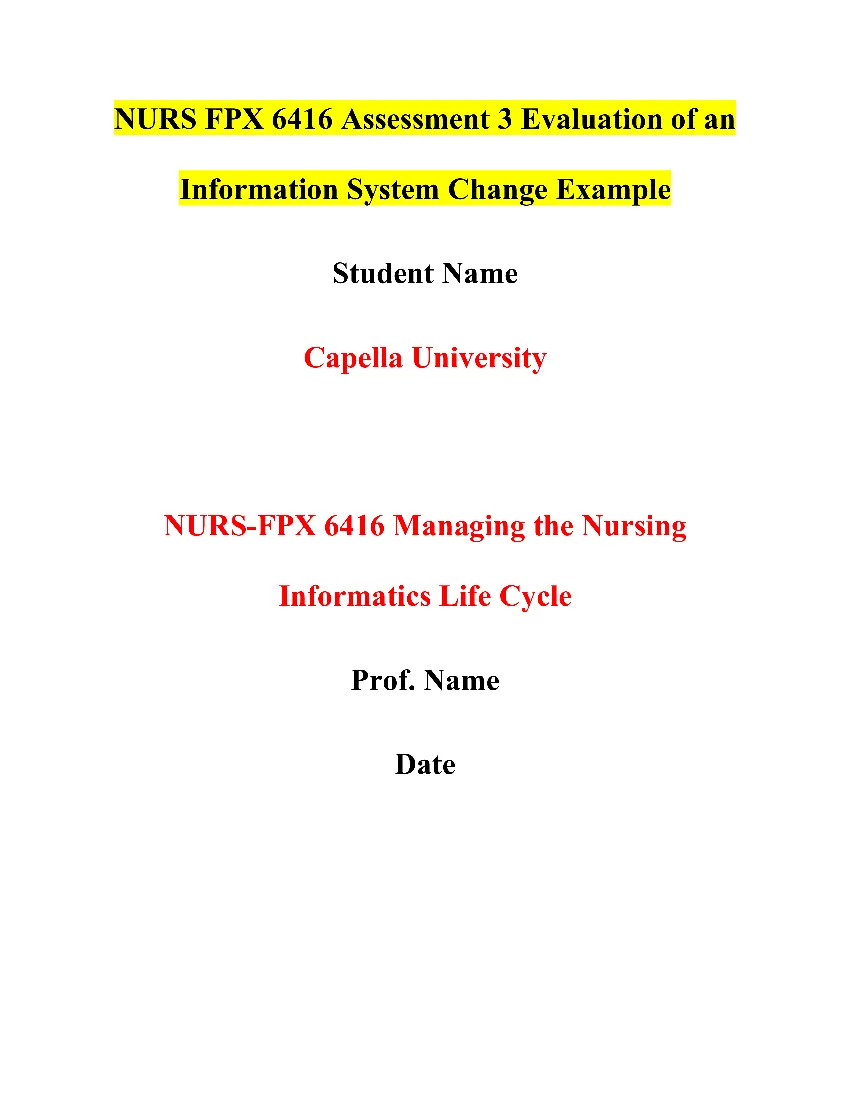 NURS FPX 6416 Assessment 3 Evaluation of an Information System Change
NURS FPX 6416 Assessment 3 Evaluation of an Information System Change
NURS FPX 6416 Evaluation of an Information System Change Paper Assignment Brief
Course: NURS-FPX 6416 Managing the Nursing Informatics Life Cycle
Assignment Title: NURS FPX 6416 Assessment 3 Evaluation of an Information System Change
Assignment Overview
In this assignment, you will analyze and evaluate the impact of an information system change within a healthcare organization. Specifically, you will assess the effectiveness of the system change in improving patient care, organizational efficiency, and technology integration.
Understanding Assignment Objectives
The primary objectives of this assignment are to:
- Analyze frameworks for evaluating the impact of an information system and system change.
- Design a comprehensive evaluation plan for monitoring the system changes.
- Communicate key findings and evaluation strategies to stakeholders effectively.
The Student’s Role
As a nursing informatics specialist, your role is to assess the impact of the information system change on patient care outcomes and organizational performance. You will utilize your expertise in information systems and healthcare management to analyze the effectiveness of the system change and propose strategies for ongoing evaluation and improvement.
Competencies Measured
This assignment measures the following course competencies:
- Evaluate strengths and liabilities of health information systems: Define relevant evaluation framework components and create a comprehensive evaluation plan aligned with project goals.
- Incorporate project management principles into nursing informatics: Summarize evidence-based rationale and actions for evaluating an organizational information system change project.
- Communicate as a practitioner-scholar: Appropriately address all components of the assignment prompt, support main points with relevant evidence, and communicate findings effectively to stakeholders.
You Can Also Check Other Related Assessments for the NURS-FPX 6416 Managing the Nursing Informatics Life Cycle Course:
NURS FPX 6416 Assessment 1 Needs Assessment Meeting with Stakeholders Example
NURS FPX 6416 Assessment 2 Technology Needs Assessment Summary and Implementation Plan Example
NURS FPX 6416 Evaluation of an Information System Change Paper Example
Introduction
Implementing changes to information systems in healthcare organizations, exemplified by Villa Hospital, is essential for overcoming barriers, reducing financial burdens, and ensuring comprehensive support and access to healthcare services for patients. The integration of Information System Changes, including remote patient monitoring and a patient portal, is anticipated to enhance both organizational performance and patients’ well-being. In modern healthcare, such initiatives are crucial for improving patient care, organizational efficiency, and technology integration. As a nursing informatics specialist, evaluating the impact of such changes is paramount. This report provides an analysis of frameworks for evaluating the impact of an information system and system change, along with a comprehensive evaluation plan tailored for Villa Hospital.
Part 1: Evaluation Report: Framework Components
The evaluation of an information system change requires a comprehensive understanding of the framework components that underpin its impact. In this section, we will analyze three key components: the quality of information, outcomes of quality care, and the structural quality of the system change (Garcia-Dia, 2019).
Quality of Information Framework Component
The quality of information generated by the information system change is fundamental to its success. It encompasses various aspects such as the correctness and completeness of data, user satisfaction with the system, incorporation of patient privacy into the system’s information, and patient satisfaction with the system (Garcia-Dia, 2019). Ensuring the accuracy and completeness of data through methods like the CRAAP test (Currency, Relevancy, Authority, Accuracy, Purpose) is crucial. Additionally, user satisfaction and patient privacy must be evaluated through surveys and adherence to guidelines such as Protected Health Information (PHI) standards (Abrams et al., 2022; Griggs et al., 2018).
Outcomes of Quality Care Framework Component
The outcomes of quality care resulting from the system change are indicative of its effectiveness in improving patient care and organizational efficiency. Key aspects include the efficiency and appropriateness of care delivered through the system. Monitoring these outcomes during the implementation phase is vital to assess the system’s impact. Efficiency can be measured through productivity and cost-effectiveness, while appropriateness of care can be evaluated based on patient feedback and health outcomes (Mohammed et al., 2019; Hathaliya et al., 2019).
Structural Quality Framework Component
The structural quality of the system change pertains to the organizational support, hardware and software effectiveness, and overall functionality of the system. Organizational support is crucial for successful implementation, while the effectiveness of hardware and software directly impacts system performance. Assessing the functionality of the system involves gathering feedback from stakeholders, monitoring system performance metrics, and ensuring alignment with organizational goals (Agarwal et al., 2019; Edwards et al., 2020).
Part 2: Evaluation Plan Table
The evaluation plan outlines a structured evaluation plan to monitor the system changes at Villa Hospital. The evaluation plan aligns with the goals defined in the implementation plan and focuses on assessing the impact of the information system change across the identified framework components: quality of information, outcomes of quality care, and structural quality (Garcia-Dia, 2019).
| Goals from Implementation Plan | Framework Component(s) | Measurements | Frequency | Rationale |
| Enhance data accuracy and completeness | Quality of Information | Conduct CRAAP test | Monthly | Ensures data reliability and relevance, aligns with PHI guidelines
|
| Improve user satisfaction with the system | Quality of Information | Administer user satisfaction surveys | Quarterly | Provides feedback on system usability and user experience |
| Ensure patient privacy compliance | Quality of Information | Audit system for PHI compliance | Bi-annually | Ensures adherence to regulatory standards and protects patient confidentiality |
| Increase system efficiency | Outcomes of Quality Care | Measure system productivity | Quarterly | Indicates system effectiveness in delivering care and optimizing resource utilization |
| Enhance appropriateness of care | Outcomes of Quality Care | Analyze patient feedback on care appropriateness | Monthly | Ensures alignment of care delivery with patient needs and expectations |
| Assess organizational support | Structural Quality | Conduct stakeholder surveys on system support | Annually | Evaluates organizational readiness and commitment to system implementation |
| Evaluate hardware effectiveness | Structural Quality | Monitor system performance metrics | Quarterly | Ensures hardware reliability and functionality in supporting system operations |
| Assess software effectiveness | Structural Quality | Collect feedback on software usability | Bi-monthly | Indicates user satisfaction with system software and identifies areas for improvement |
| Measure overall system functionality | Structural Quality | Review system functionality against objectives | Bi-annually | Assesses system’s ability to meet organizational goals and fulfill user requirements |
The chosen measurements and their frequencies are designed to provide ongoing insights into the effectiveness of the information system change. By regularly assessing these metrics, we can track progress, identify areas for improvement, and ensure alignment with organizational objectives and patient care goals. This structured approach to evaluation will facilitate evidence-based decision-making and continuous improvement in the information system at Villa Hospital.
Part 3: Overview Discussion with Stakeholders
The discussion aims to highlight key findings, strategies for ongoing monitoring, and the rationale behind the chosen evaluation measures (Garcia-Dia, 2019). Stakeholders, including the IT team, administrators, project managers, nurse informaticists, and Clinical Informatics, are integral to the change implementation process. The evaluation report and plan address concerns such as patient dissatisfaction and nurse burden. By implementing remote patient monitoring and patient portals, we aim to enhance patient care, reduce mortality rates, and alleviate nurse burden, ultimately improving overall healthcare outcomes.
Introduction to the Project
At Villa Hospital, we are committed to enhancing patient care and organizational efficiency through the implementation of information system changes. Our project focuses on integrating remote patient monitoring and patient portals to improve access to healthcare services and streamline communication between patients and healthcare providers.
Discussion of the Evaluation Report
The evaluation report provides insights into the impact of the information system change across three key framework components: quality of information, outcomes of quality care, and structural quality. We have assessed data accuracy, user satisfaction, patient privacy compliance, system efficiency, appropriateness of care, organizational support, hardware and software effectiveness, and overall system functionality.
Discussion of the Evaluation Plan
Our evaluation plan outlines a structured approach to monitor the system changes and assess their effectiveness over time. We will regularly conduct measurements aligned with the goals of the implementation plan, including CRAAP tests for data accuracy, user satisfaction surveys, audits for PHI compliance, productivity assessments, patient feedback analysis, stakeholder surveys, system performance monitoring, and feedback collection on software usability.
Conclusion
In conclusion, the evaluation of an information system change is essential for assessing its impact on healthcare organizations like Villa Hospital. By analyzing the framework components of quality of information, outcomes of quality care, and structural quality, we gain insights into the effectiveness of the system change in enhancing patient care and organizational efficiency. The evaluation plan provides a structured approach to monitor the system changes and ensure alignment with organizational goals and patient care objectives. Through ongoing assessment and stakeholder engagement, we can drive continuous improvement and optimize the benefits of the information system change at Villa Hospital.
References
Abrams, S., Delf, L., Drummond, R., & Kelly, K. (2022). The CRAAP Test. Open. Oregon state.education. https://open.oregonstate.education/goodargument/chapter/craap-test/
Agarwal, S., Sripad, P., Johnson, C., Kirk, K., Bellows, B., Ana, J., Blaser, V., Kumar, M. B., Buchholz, K., Casseus, A., Chen, N., Dini, H. S. F., Deussom, R. H., Jacobstein, D., Kintu, R., Kureshy, N., Meoli, L., Otiso, L., Pakenham-Walsh, N., & Zambruni, J. P. (2019). A conceptual framework for measuring community health workforce performance within primary health care systems. Human Resources for Health, 17(1). https://doi.org/10.1186/s12960-019-0422-0
Al-khafajiy, M., Baker, T., Chalmers, C., Asim, M., Kolivand, H., Fahim, M., & Waraich, A. (2019). Remote health monitoring of the elderly through wearable sensors. Multimedia Tools and Applications, 78(17), 24681–24706. https://doi.org/10.1007/s11042-018-7134-7
Edwards, K., Prætorius, T., & Nielsen, A. P. (2020). A model of cascading change: orchestrating planned and emergent change to ensure employee participation. Journal of Change Management, 20(4), 1–27. https://doi.org/10.1080/14697017.2020.1755341
Griggs, K. N., Ossipova, O., Kohlios, C. P., Baccarini, A. N., Howson, E. A., & Hayajneh, T. (2018). Healthcare blockchain system using smart contracts for secure automated remote patient monitoring. Journal of Medical Systems, 42(7). https://doi.org/10.1007/s10916-018-0982-x
Hathaliya, J., Sharma, P., Tanwar, S., & Gupta, R. (2019). Blockchain-based remote patient monitoring in healthcare 4.0. 2019 IEEE 9th International Conference on Advanced Computing (IACC). https://doi.org/10.1109/iacc48062.2019.8971593
Menear, M., Blanchette, M.-A., Demers-Payette, O., & Roy, D. (2019). A framework for value-creating learning health systems. Health Research Policy and Systems, 17(1). https://doi.org/10.1186/s12961-019-0477-3
Mohammed, K. I., Zaidan, A. A., Zaidan, B. B., Albahri, O. S., Alsalem, M. A., Albahri, A. S., Hadi, A., & Hashim, M. (2019). Real-time remote-health monitoring systems: a review on patients prioritisation for multiple-chronic diseases, taxonomy analysis, concerns and solution procedure. Journal of Medical Systems, 43(7), 223. https://doi.org/10.1007/s10916-019-1362-x
Wang, Y., Kung, L., & Byrd, T. A. (2018). Big data analytics: Understanding its capabilities and potential benefits for healthcare organizations. Technological Forecasting and Social Change, 126(1), 3–13. https://doi.org/10.1016/j.techfore.2015.12.019
Detailed Assessment Instructions for the NURS FPX 6416 Evaluation of an Information System Change Paper Assignment
Description
Assessment 3 Instructions: Evaluation of an Information System Change
Write a 3-4 page evaluation report analyzing the frameworks for evaluating the impact of an information system and system change.
Create an Excel or Word table evaluation plan for the project. Record an audio memo of three minutes or fewer to explain your plan to stakeholders. Introduction
Note:
Each assessment in this course builds on the work you completed in the previous assessment. Therefore, you must complete the assessments in this course in the order in which they are presented. With any new or changed system, you should be working to ensure that the information system has functionality in the form of interoperability and integration of information. As part of the evaluation process, you should assess the interoperability and integration of system information. You will present these findings for the stakeholders to acknowledge and confirm. As part of your work as the nursing informatics specialist, you have developed and implemented an information system change in your organization. Now it is time to design an evaluation report about the change and to put into place a consistent method for a system evaluation plan.
Note:
Complete the assessments in this course in the order in which they are presented. Instructions Your submission will include three parts.
The first part will be a written 3–4 page evaluation report, in which you will analyze the frameworks for evaluating the impact of an information system and system change.
The second part will be a single page evaluation plan table.
The third part will be a recorded audio or video overview discussion for stakeholders.
The recording must be 3 minutes in duration or fewer.
You can submit Parts 1 and 2 together as one document with the table listed as an appendix.
Part 1:
Evaluation Report For this part of your submission, you will define the three types of framework components.
One is related to quality of information that is generated by the information system change, the second relates to the effects on outcomes of quality care due to the system change, and the third is the structural quality of the system with the change (Garcia-Dia, 2019, p. 376).
One way to organize this report is as follows:
When defining the quality of information framework include:
- The development of completeness or correctness of data.
- User satisfaction with the system.
- Patient privacy that is incorporated into the system’s information.
- Patient satisfaction with the system.
When defining outcomes of quality care framework include:
- Efficiency with the use of the system.
- Appropriateness of care with the use of the system.
When defining the structural quality framework include:
- Organizational support given to the system.
- Effectiveness of hardware for the use of the system.
- Effectiveness of software when using the system.
- Overall functionality of the system.
Part 2:
Evaluation Plan Table For this part of your submission, you will design an evaluation plan to monitor the system changes (Garcia-Dia, 2019, p. 379).
You will use the goals that you defined as part of your implementation plan as a starting point for constructing your table.
One way to organize your table is as follows:
First Column:
- Goals from the implementation plan.
Second Column:
- Framework component or components (defined in Part 1) that best fit each goal.
Third Column:
- Define at least two measurements for each goal.
Fourth Column:
- Define the frequency of measurement.
Fifth Column:
- Briefly explain why you are using the chosen measures related to the outcomes that you want to achieve with the new system change.
Part 3:
Overview Discussion with Stakeholders
For this part of your submission, you will record an audio and video discussion of highlights from your evaluation report and evaluation plan for stakeholders (including the implementation team).
Your recording must be 3 minutes in duration or fewer. Include the following in your recording:
- Brief introduction to the project.
- Discussion of the evaluation report that provides a brief overview of how the system is currently functioning from several perspectives related to the framework components.
- Discussion of the evaluation plan that provides the stakeholders information about:
- What will you monitor ongoing with the system?
- How will you accomplish the monitoring?
- When will you monitor?
- Why are you monitoring these specific data points?
- Brief conclusion to provide stakeholders with the one or two most cogent talking points.
Requirements
Evaluation Report Length:
- 3–4 pages in length, not including the title and reference page.
APA Style and Format:
- Use APA formatting with a title page, running head, title on the first page of text, level 1 headings, and a reference list.
Number of References:
- Include 3–5 scholarly sources used as parenthetical citations and in a reference list.
Evaluation Plan:
- Create a 1-page Excel or Word table to illustrate your evaluation plan.
- If you use a Word table, include it at the end of your evaluation report and designate the evaluation plan table using the appropriate APA style headings.
Overview with Stakeholders Recording:
- Upload your Kaltura video to the assessment area.
Recording Length:
- No longer than 3 minutes.
- Refer to Using Kaltura for directions on recording and/or uploading your video in the courseroom.
Note:
If you require the use of assistive technology or alternative communication methods to participate in these activities, please contact DisabilityServices@Capella.edu to request accommodations.
Competencies Measured
By successfully completing this assessment, you will demonstrate your proficiency in the following course competencies and assessment criteria:
- Competency 1: Evaluate strengths and liabilities of health information systems. Define three evaluation framework components that are relevant and appropriate for an organizational information system change project. Create a comprehensive evaluation plan for an organizational information system change project that lays out framework components, measurements, frequency of measurements, and rationale for measurements as aligned to specific project goals.
- Competency 2: Incorporate project management principles into nursing informatics. Summarize the evidence-based rationale and specific actions that will be undertaken as part of the evaluation of an organizational information system change project for stakeholders.
- Competency 4: Communicate as a practitioner-scholar, consistent with the expectations of a nursing professional. Appropriately address all components of the assignment prompt, using the assignment description to structure text. Support main points, assertions, arguments, conclusions, or recommendations with relevant and credible evidence. Communicate orally in a clear and concise manner, which helps to clarify key information and expectations for stakeholders in a presentation of 3 or fewer minutes.
Boost Your Grades with ReliablePapers.com – Your Expert Nursing Paper Writing Service!
Are you struggling with nursing research papers or assignments? Look no further! At ReliablePapers.com, we’re your trusted nursing writing service, committed to delivering customized and original nursing papers for top-notch grades.
Writing Nursing Assignments Made Easy
Dealing with complex topics, tight deadlines, or specific instructions? Our skilled nursing essay writers are here to help. From crafting custom nursing research papers to assisting with nursing assignments, we ensure top grades for your academic success.
Timely Support for Your Coursework, Top Grade Assured
With years of experience helping nursing students with coursework, we efficiently handle orders even with tight deadlines. Our expert nursing writers create outstanding papers from scratch, addressing any topic, meeting any deadline, and following your specific instructions.
Why Choose Nursing Paper Writing Services at ReliablePapers.com?
- Affordable Prices: Our online nursing papers are priced affordably, ensuring accessibility for all college students.
- Expert Writers: Let our skilled writers make your paper perfect, providing the expertise needed for exceptional results.
- Originality Guaranteed: Say goodbye to plagiarized papers. Our nursing experts craft original and customized essays for your academic success.
- Easy Ordering Process: Ready to place your order? It’s hassle-free! Visit our “Place Order” page, provide paper details, proceed to checkout, and your order will be assigned to a suitable expert.
Why Trust Our Professionals?
Our skilled writers at ReliablePapers.com are updated with the latest nursing trends, ensuring your research paper stands out. Trust us for your academic success – our online nursing essays are unmatched both in quality and affordability.
As a nursing student, balancing assignments and class participation can be overwhelming. Seek help to submit research on time and ensure exceptional performance in your nursing papers. Trust ReliablePapers.com for your academic success! Order your nursing essays today, save time, and secure the grades you deserve.
Don’t wait until the last minute; fill in your requirements, and let our experts deliver your work ASAP. Place Your Order Now.
Hire an Expert Paper Writer on Any Subject, Any Topic, Any Deadline! Submit your paper instructions by placing your order here to get started!


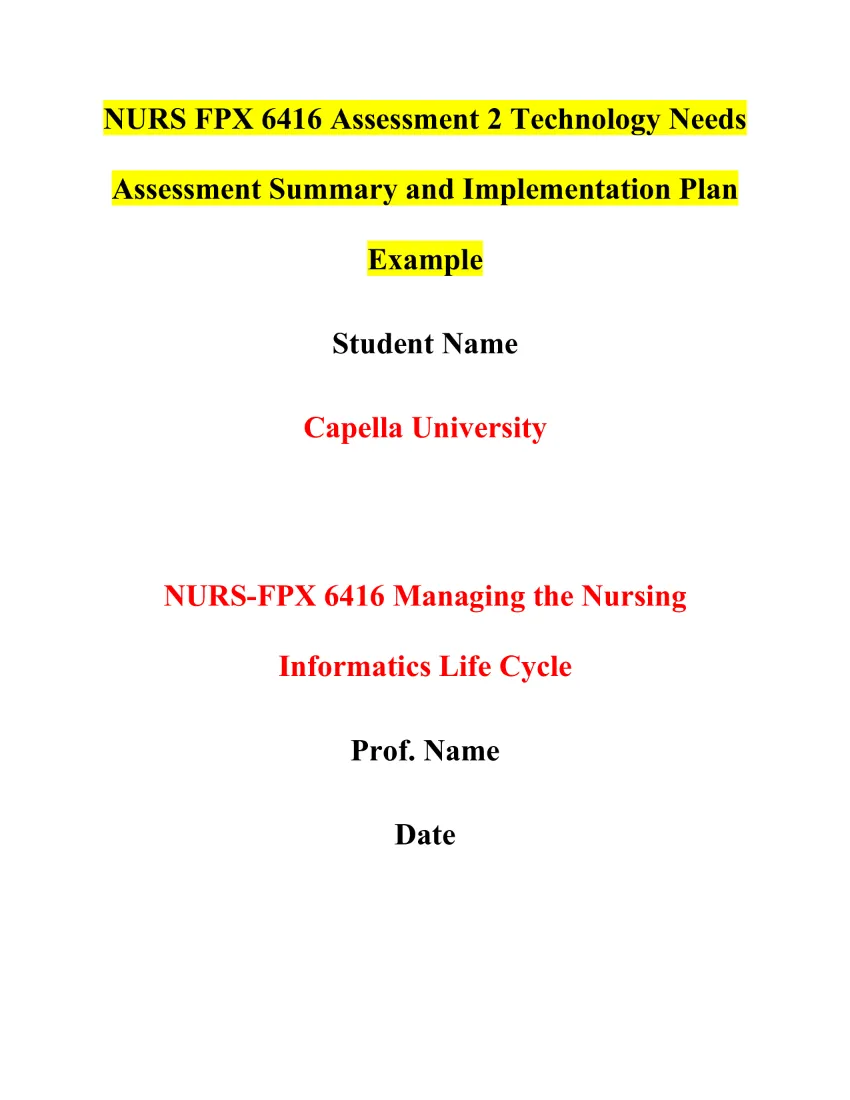 NURS FPX 6416 Assessment 2 Technology Needs Assessment Summary and Implementation Plan
NURS FPX 6416 Assessment 2 Technology Needs Assessment Summary and Implementation Plan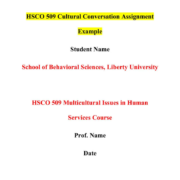 HSCO 509 Cultural Conversation Assignment Brief
HSCO 509 Cultural Conversation Assignment Brief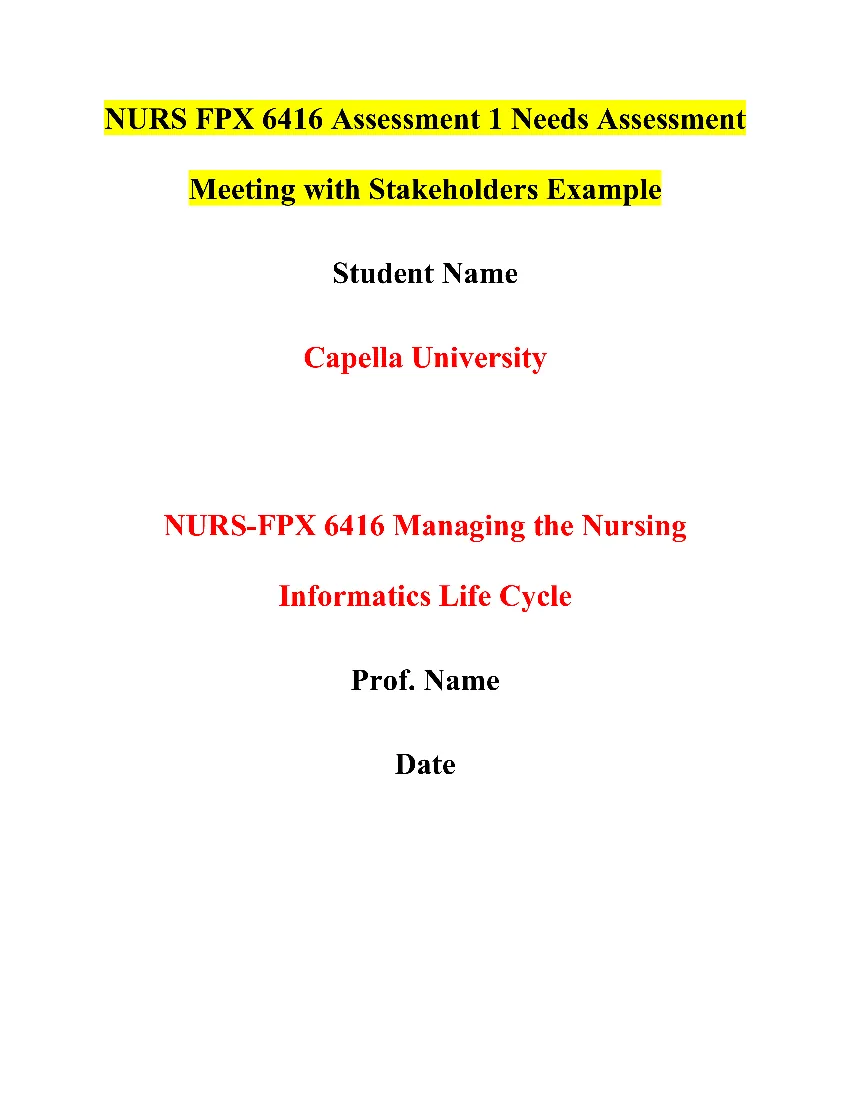 NURS FPX 6416 Assessment 1 Needs Assessment Meeting with Stakeholders
NURS FPX 6416 Assessment 1 Needs Assessment Meeting with Stakeholders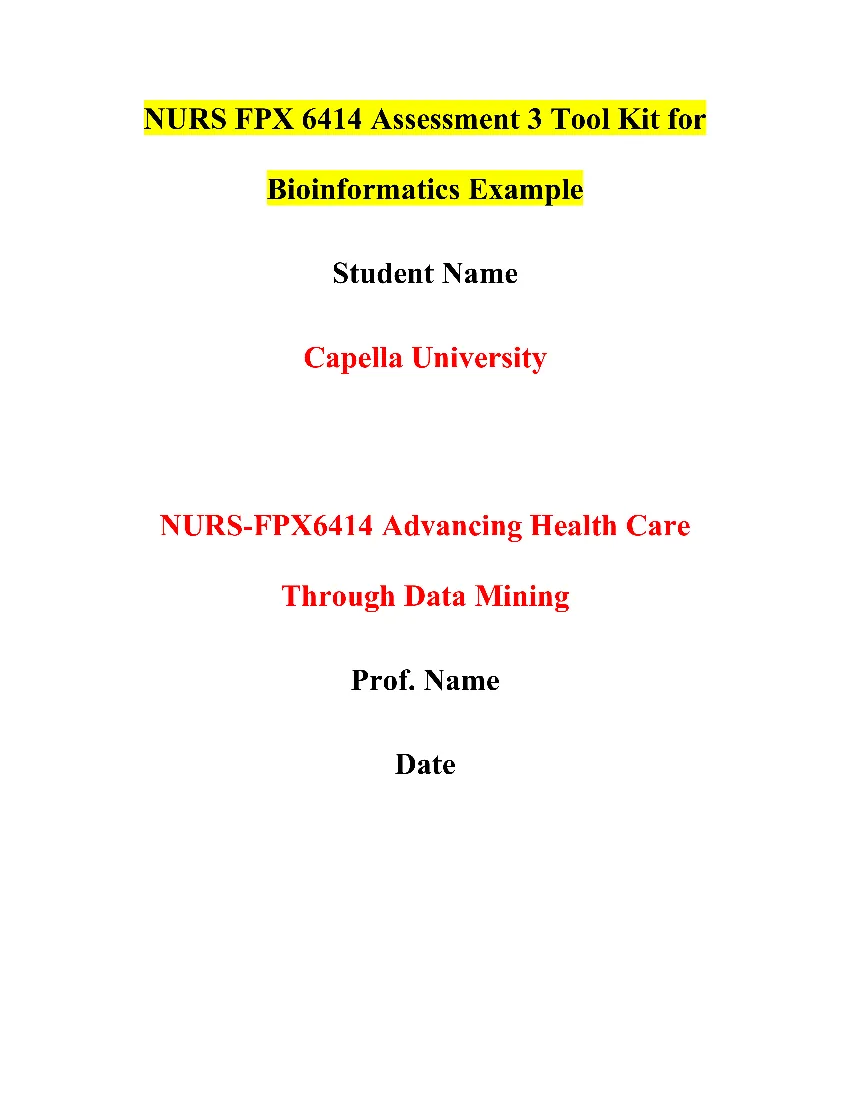 NURS FPX 6414 Assessment 3 Tool Kit for Bioinformatics
NURS FPX 6414 Assessment 3 Tool Kit for Bioinformatics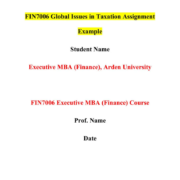 FIN7006 Global Issues in Taxation Assignment Brief
FIN7006 Global Issues in Taxation Assignment Brief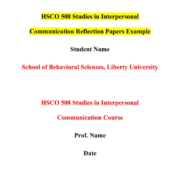 HSCO 508: Studies in Interpersonal Communication Reflection Papers Assignment Brief
HSCO 508: Studies in Interpersonal Communication Reflection Papers Assignment Brief FIN7007 Managing Strategic Finance and Risk Assignment Brief
FIN7007 Managing Strategic Finance and Risk Assignment Brief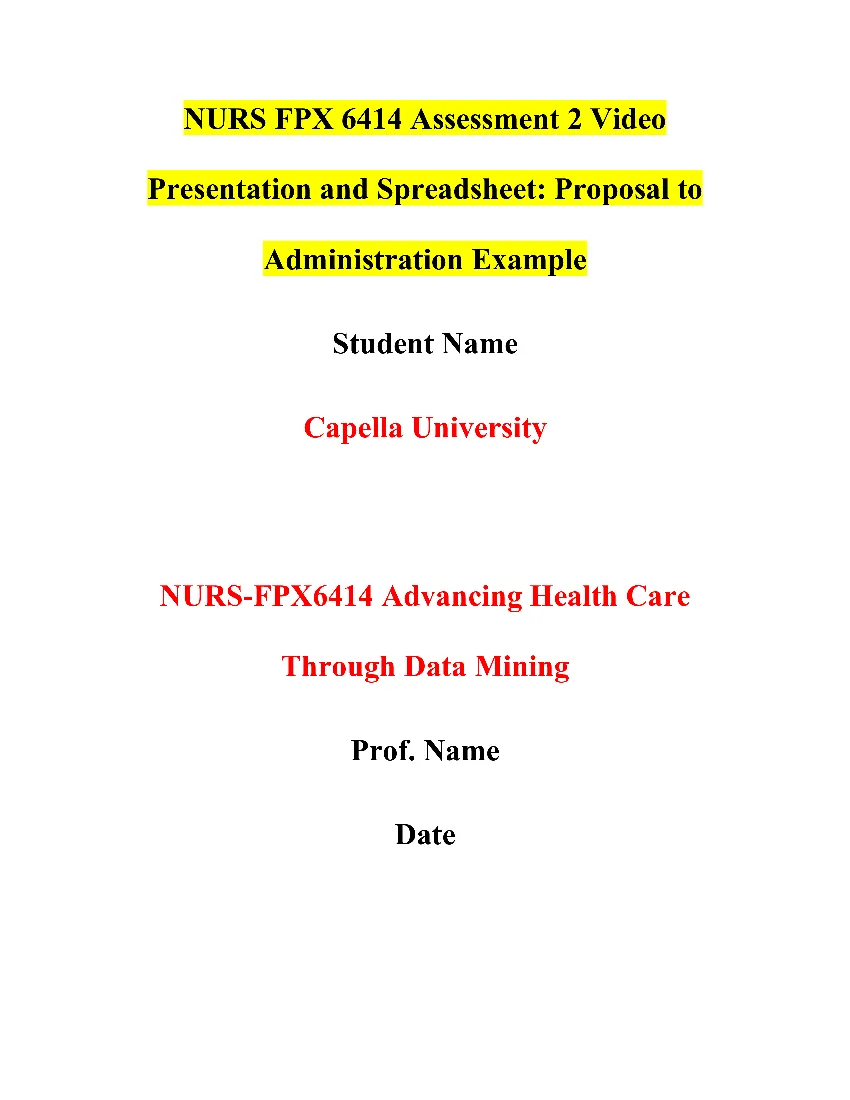 NURS FPX 6414 Assessment 2 Video Presentation and Spreadsheet: Proposal to Administration
NURS FPX 6414 Assessment 2 Video Presentation and Spreadsheet: Proposal to Administration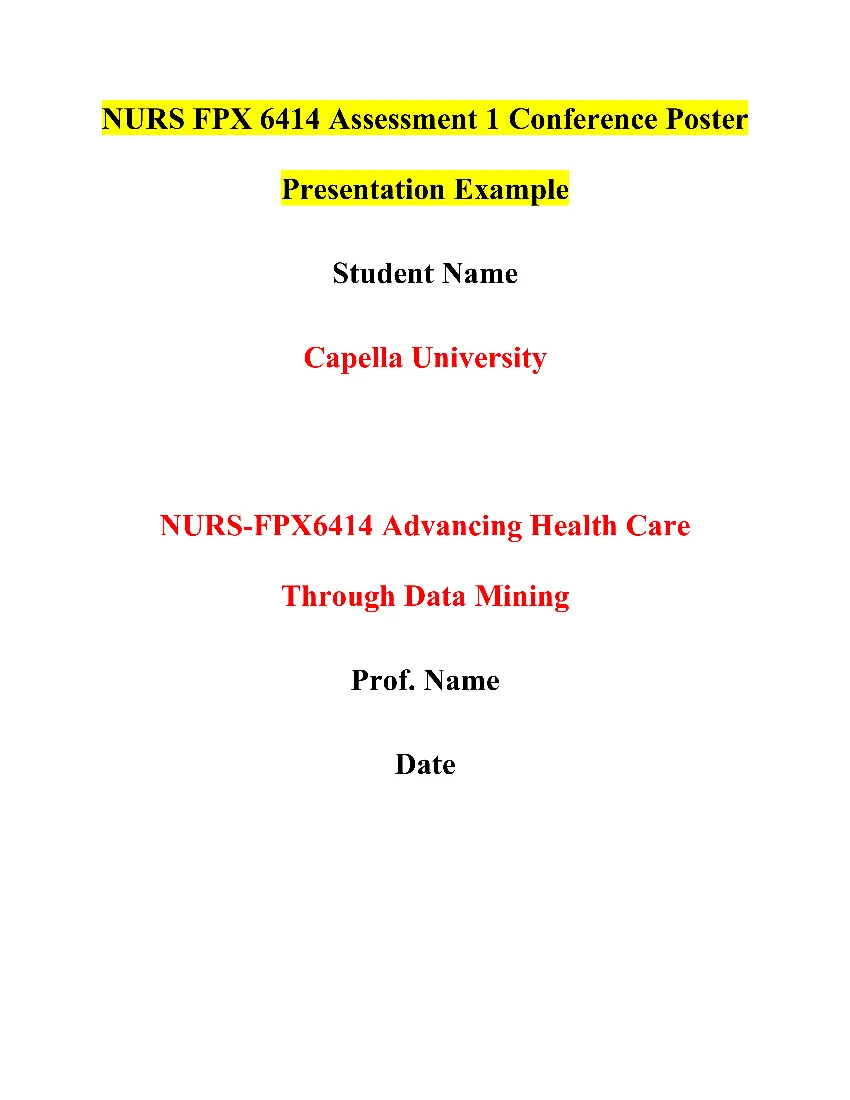 NURS FPX 6414 Assessment 1 Conference Poster Presentation
NURS FPX 6414 Assessment 1 Conference Poster Presentation